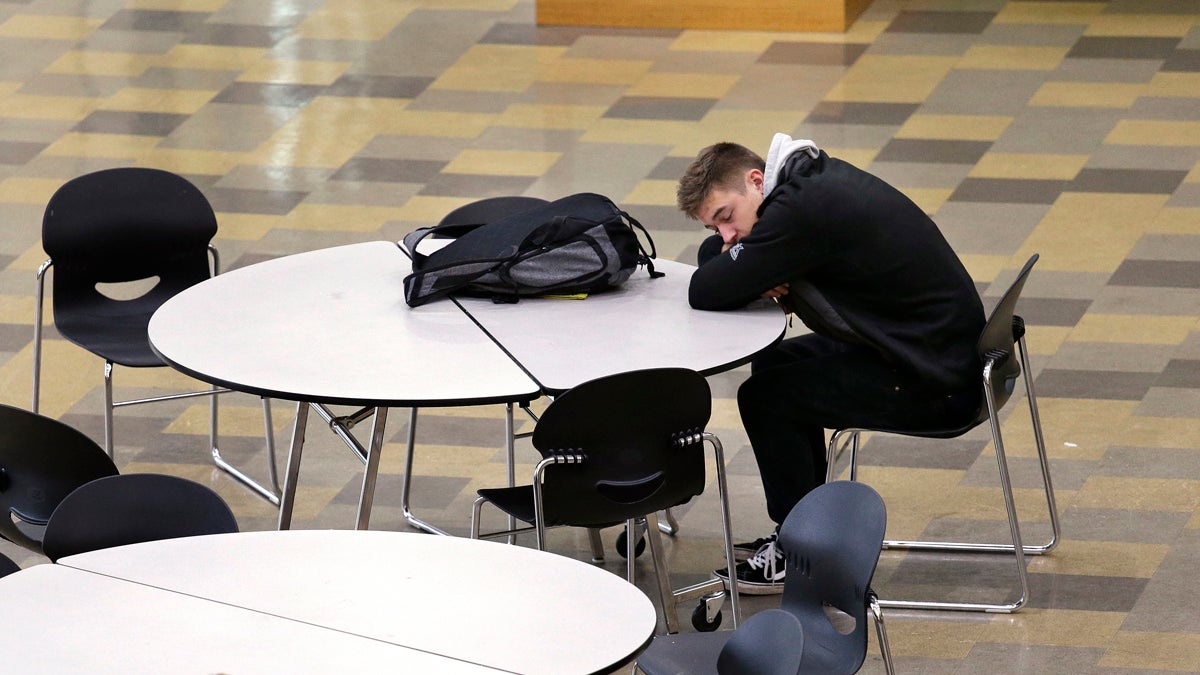Heeding science, some Pennsylvania school districts push back high school start times
Later school start times could mean teenagers are more likely to get adequate amounts of sleep, according to research published last month by Penn State researchers.

In this photo taken Nov. 23, 2015, a student leans on a table in the cafeteria during first period at Roosevelt High School in Seattle. More school districts around the U.S. are heeding the advice of scientists who have long said that pushing back school start times can improve student health or academic output. (Elaine Thompson/AP Photo)
Later school start times could mean teenagers are more likely to get adequate amounts of sleep, according to research published last month by Penn State researchers.
That study supports a 2014 recommendation from Centers for Disease Control and Prevention and the American Academy of Pediatrics that middle and high schools start no earlier than 8:30am in order to give students more time to sleep.
A few Pennsylvania school districts in turn are adjusting schedules or considering moving back when teenagers start the school day.
For instance, last month the State College Area school board approved changing the beginning of the day for elementary through high school, pushing the start for high school students to 8:40.
Avonworth School District, north of Pittsburgh, also recently made a switch.
Starting this year, students there arrived at their first period, for the most part, after sunrise.
The High School shifted its first period start time from 7:15 to 8 a.m., and Superintendent Thomas Ralston said his students now pass what he calls “the eye test.”
“You can see that kids are coming to school, and they’re awake. They’re coming in when it’s light outside,” he said. “Our faculty have reported that kids are more attentive in class … and faculty feel more prepared.”
Teachers are still arriving to school at 7:15 and use the time to prepare for the day, he said.
Making the logistics work
In Pennsylvania, school start time is a local decision. The Pennsylvania Association of School Administrators says while research validates later start times, there are significant hurdles for districts looking to make the move including transportation and after-school activity schedules.
For Avonworth, it was a fairly simple move. The district used to have three bus runs, one each for the elementary, middle and high school. Now, the middle and high school operate buses at the same time, and about 800 students dismiss from the two schools at once.
At first, that made superintendent Ralston nervous, but he said it was ultimately a good move. The high school has recorded 500 fewer absences compared to the 2015 school year.
Two big hurdles for any district considering a change will be adjusting transportation and commitments to established extracurricular activities, Ralston said, but it’s doable. Buses might be out later, and practice and competition schedules could need to be moved.
“We’re going to continue to make adjustments and make sure what we’re doing is meeting the needs of our kids,” Ralston said. “First and foremost, we need to look out for the health of our kids.
Other Western Pennsylvania school districts are trying it, too.
Quaker Valley High School shifted students’ schedules from 7:45 to 8 a.m. this fall. Hampton Township, which begins at 7:30 a.m., is also considering a move.
Teenagers need more sleep
While adults may be ready to teach before the sun rises, there’s a case for blaming students’ needs on biology rather than laziness.
University of Pittsburgh psychiatry professor Peter Franzen said changes in puberty make it harder to fall asleep at night, and research shows that most teenagers aren’t getting enough sleep.
“There’s an association between higher grades, performance, achievement, [and] test scores with longer sleep duration. So it seems that short sleep is a risk factor for poor academic performance,” he said.
Teens’ circadian rhythms are delayed compared to adults, which means adolescents naturally prefer going to sleep and waking up later, he said.
“It looks like when we try to force adolescents into acting like adults, they suffer from more problems like doing worse in school, car accidents, more depression and other kinds of negative consequences,” he said.
According to Franzen, that sparked a national movement which has trickled down to districts in Pennsylvania.
At North Allegheny, a Pittsburgh-area district, a survey last year found its 7:25 a.m. start time was a factor in student stress levels, communications specialist Emily Schaffer said. The board there considered pushing back to 8 a.m.
Franzen also cites studies that show an association between kids who get less sleep and increases in depression and suicide attempts.
“I’m convinced by the science that’s out there that suggests that the later we send kids to school the better they tend to do. This is data that either comes from schools that have made the change or just looking at what we know in terms of all the risks and negative consequences associated with kids who get short sleep,” he said.
WHYY is your source for fact-based, in-depth journalism and information. As a nonprofit organization, we rely on financial support from readers like you. Please give today.






